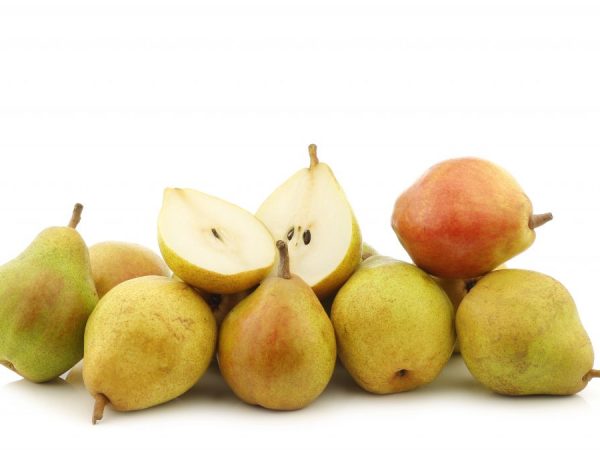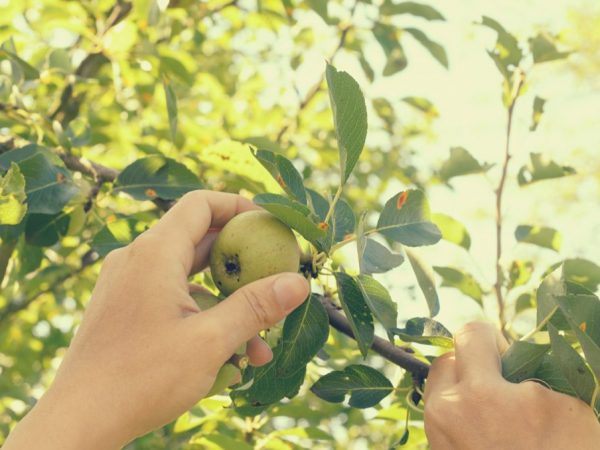Characteristics of the pear variety Dessertnaya Rossoshanskaya
Dessert Pear Rossoshanskaya is a variety of dessert pears with an average ripening period. This species was bred by mixing the Forest Beauty (characterized by excellent taste characteristics) and the winter Bere Michurin (distinguished by its resistance to frost). We will consider a detailed description of the variety in the article.

Characteristics of the pear variety Dessertnaya Rossoshanskaya
Characteristics of the variety
Dessert pear has an excellent taste and a lot of nutrients. Its fruits are used for making juices, jams, cooking compotes and freezing them for further use in winter.
Dessert Rossoshanskaya is different:
- high yield rate. Up to 30 kg of pears can be harvested from 1 tree.
- scab resistance;
- the ability to transport fruits over long distances;
- using the fruit for a variety of purposes.
- cold resistance. Even at a temperature of -20 ° C, the quality of future fruits does not deteriorate.
Description of the tree
The variety of pears Dessertnaya Rossoshanskaya is distinguished by an elongated crown in the shape of a pyramid and can reach 15 meters in height. Produces few young shoots and has a moderate leafiness.
Shoots are slightly thickened, even. They have weak pubescence. The branches are almost perpendicular to the ground and have a reddish tint. The stem bark of a pear is gray with a silvery tint.
The inflorescence is an umbrella with a large number of white calyx flowers. The petals are closed, folded. The leaves are directed upwards, of medium size, with a predominantly emerald color. In middle age, the variety blooms.
Description of the fetus
The fruits of the late dessert pear are small in size with an average weight of about 150 g. They resemble an apple of a beautiful, even shape. Quite smooth to the touch. At the time of consumption, it is covered with greenish subcutaneous dots, and the pear itself has a light yellow color. In the cover period - on a smaller surface area of the fruit, the color changes from light yellow to a slight blush of pink.
Harvesting in the south of the Voronezh region falls at the beginning of autumn, and the consumption period can last up to three months. That is why Rossoshanskaya Dessertnaya belongs to the family of autumn varieties.

The fruits are shaped like an apple, their average weight is about 150 g
Description of fruits:
- thickened stalk of medium length;
- brown oval seeds;
- juicy pulp with a unique taste;
- long-term storage after harvest;
- marketable condition;
- versatility in use.
Do not eat the fruit immediately after harvest. To achieve maximum taste, they need to lie at room temperature for 5-7 days. For storage, pears are laid out side by side at a cool temperature. The higher the temperature, the faster they ripen.
Care and landing
Pear Dessert Rossoshanskaya prefers loosened soil. It is filled with oxygen and stimulates the growth of seedlings.A little clay does not hurt, in order to maintain moisture at the very base of the roots.
The future landing site should be well lit by the sun. It is best to choose a location on the southwest side of the hill. The root system likes dampness, but from an overabundance of it, the tree can begin to wither.
You can plant a tree in late spring, but better in early autumn. It is necessary to prepare the pits for planting in advance.
Planting stages
- The layer of earth removed from the pit must be mixed with fertilizers (peat, compost, manure). Pour the resulting mixture to the brim into the pit.
- Pour soil with a slide at the bottom of the hole and hammer a peg in the middle. Place the seedling in the hole and spread the roots. Cover with earth on top and tamp lightly.
- After planting, water the plant abundantly with two buckets of water and mulch the soil around. Tie a tree to a peg.
The Rossoshanskaya pear needs warmth and protection from the wind. Otherwise, the pear will not produce good fruit.
Also, do not neglect circumcision. It is necessary to trim the crown or roots of the tree. In addition, growth hormones can be used to regulate the corresponding process.
Pruning
In the first year of life, the tree is not pruned, and in the second year, they begin to form a crown. The crown is formed within three years.
One tier is made every year, which consists of several skeletal branches. You need to make a distance of about 50 cm between the tiers. An old tree needs to remove dried branches, as well as branches that have sunk strongly to the ground.
Watering
Despite the fact that Dessertnaya Rossoshanskaya is drought-resistant, it needs abundant watering. It is recommended to do 3-4 waterings during the season. The amount of water depends on the climate and weather in the area where the tree grows.
Two buckets of water will be enough for a young plant. An older tree needs two buckets of water for every year it lives.

Pear Dessert Rossoshanskaya prefers loosened soil and abundant watering
Fertilization
In the second life, you can start feeding the tree. Fertilizers are applied in autumn and spring, and top dressing is done in summer.
Mineral fertilizers are applied annually, and organic fertilizers are applied every few years. Fertilizers must be applied to a pre-dug ditch around the tree. The length of the ditch depends on the amount of fertilizer. First, mineral fertilizers are poured into the ditch, mixed with soil, and then organic.
Diseases and pests
The variety is highly immune to scab.
Description of pests that can have a negative effect on the pear:
- Winter moth. The winter moth is a yellow caterpillar of short length, which lays eggs in the bark near the buds. The caterpillar eats the buds, and also gnaws at the leaves and branches. The caterpillar hides in the leaves entangled in cobwebs. To protect your plant from it, you need to whitewash the pillar in time and clear it of moss.
- Pear sawfly. The caterpillar is red in color with a black head. This pest eats up the pulp on the fruits and settles in the cobweb on the leaves. To protect against pests, you need to follow the rules for growing a tree and dig up the earth near the tree trunk.
- Pear fruit lane. It is a white caterpillar with a dark head. This pest infects the fruits and eats up the seeds inside them, as a result of which the fruits fall prematurely. As a fight against this insect, it is necessary to mulch the soil and destroy the affected fruit.
As a preventive measure, you should constantly inspect the tree. This will help to notice the disease at an early stage of development and quickly take certain actions.
Conclusion
The pear variety Dessertnaya Rossoshanskaya has a good yield and an autumn harvest. It is hypoallergenic and approved for use by children.
The plant has good immunity and resistance to scab damage. The fruits have excellent consumer qualities and are versatile in use.The fruits she gives will decorate any festive table.


